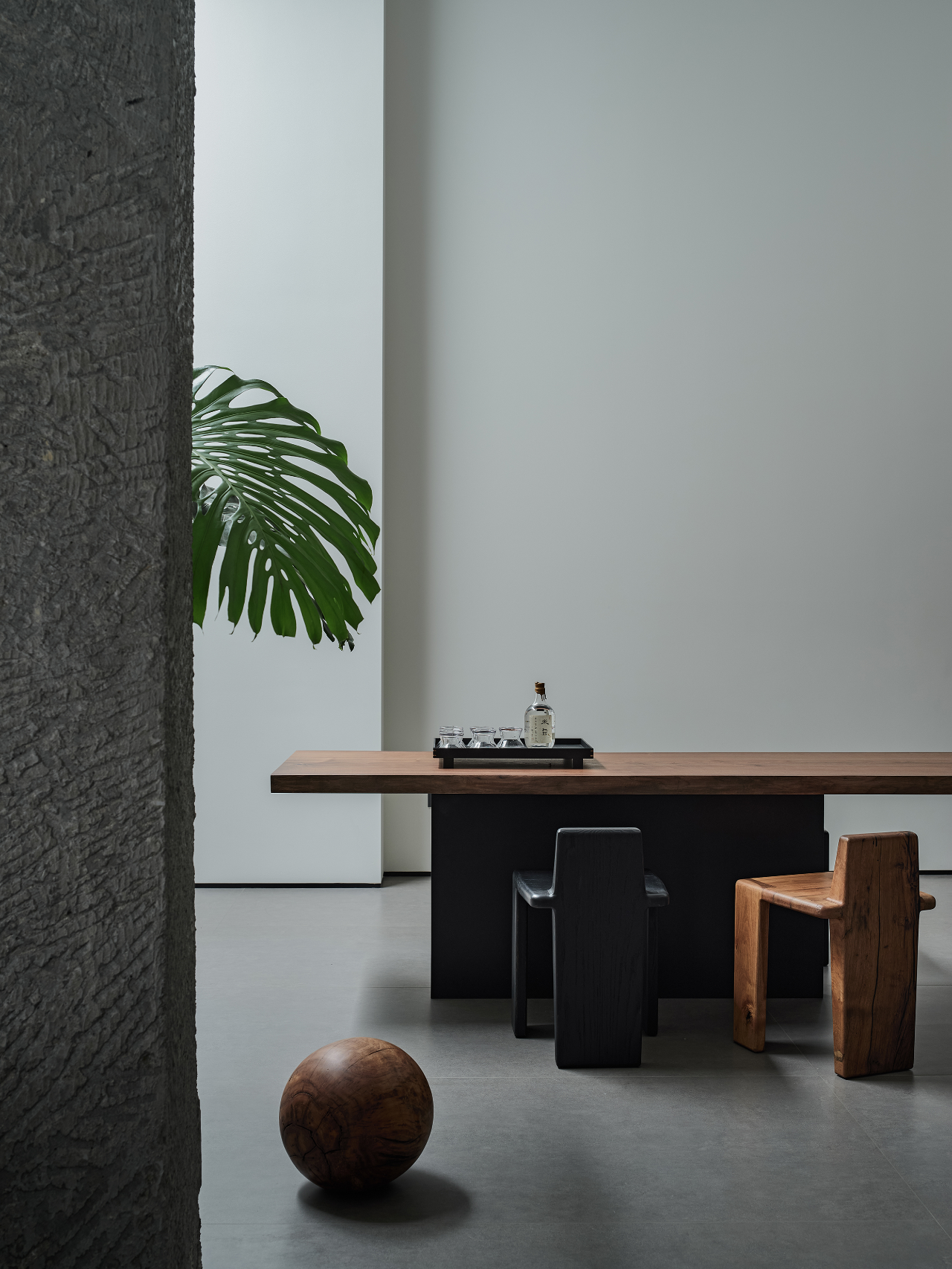SawMill House Archier Studio
2015-08-17 17:00
架构师提供的文本描述。锯木厂大厦采用大型再生混凝土块,将其固定在景观中,并采用动态的主动建筑围护结构来调节内部环境。该住宅是一个手工制作的升级,从一个现有的相当乡土,波西米亚的住所,适合一个地区的雕刻家。
Text description provided by the architects. The Sawmill House uses large reclaimed one tonne blocks of reclaimed concrete which anchor it into the landscape and a dynamic active building envelope to regulate the internal environment. The dwelling is a hand crafted upgrade from an existing rather rustic, bohemian abode, befitting a regionally based sculptor.
充分利用客户的技能是首要任务。在开始施工前一年,我们通过一个粗略的计划促进了这一点,然后慢慢地开发了设计,同时在构建的过程中与现场的客户进行了实际的工作。这种设计/构建方法使我们能够摆脱传统的解决方案,研究定制度高、成本效益高的替代方案。屋顶和门面的大面积可以机械化,整个玻璃墙可以转动,庭院可以增加,定制家具、细木工和五金可以实时设计和制造。通过手工接触获得的知识对于我们年轻的实践发展是非常有价值的。
Leveraging our client’s skill set was a priority. We facilitated this with a rough plan a year prior to the start of construction, then slowly developed the design whilst physically working with the client on-site for the duration of the build. This design/build approach allowed us to move away from conventional solutions and investigate highly bespoke yet cost effective alternatives. Large sections of the roof and facade could be mechanised, entire walls of glass could pivot, courtyards could be added, custom furniture, joinery and hardware could be design and manufactured on-site in realtime. The knowledge gained through a hands on approach has been incredibly valuable to the development of our young practice.
再生混凝土块的使用是利用每年浪费的数千吨混凝土的试验。每个区块都是来自该地区一个或多个项目的卡车中剩馀混凝土的副产品,这些混凝土被倒进了粗糙的钢槽中。我们继续调查利用工业副产品,通过我们在RMIT大学经营的设计工作室,并推动的概念,包括空间和程序副产品的要素的实践。
The use of the reclaimed concrete blocks is an experiment in harnessing the thousands of tonnes of concrete that goes to waste each year. Each block is a by-product of excess concrete left in trucks from one or more projects in the region, poured into rough steel troughs. We have continued to investigate leveraging industrial by-products through a design studio we run at RMIT University and have pushed the concept to include the spacial and procedural by-product elements of practice.
What contribution does the design make to the lives of the inhabitants?
As explained by the client:
“SawmillHouse接待了我们三口之家,他们现在可以舒适和安全地生活在工业区内。大型可操作的阳台、屏风和门改变了空间,以适应各种气候和社会条件,这对我们的家庭至关重要,他们必须在不同的、有时是极端的气候中运作,并通过一系列私人务虚会将我们的家引向公共中心。重要的是,该设计的公民性质使该建筑成为一个设计办公室,具有奇妙的一面“。
“The Sawmill House hosts our young family of three, who can now live comfortably and safely within the industrial zone. Large operable veranda, screens and doors transform the space to suit various climatic and social conditions, which is crucial to our family who must operate in a diverse and sometimes extreme climate, and direct our home through a spectrum of private retreat to communal hub. Importantly, the civic nature of the design allows the building to function as a design office with a fantastic aspect”.
Relationship of the built form to the context of the project.
一吨重的混凝土砌块构成了住宅围墙的周长,每一块都有一个故事-一座桥、一条小径、一个家;在建筑的正面形成一片颜色和纹理的拼图。这种纹理支撑着工地上的建筑,因为这些层的颜色模仿了在成为当地锯木厂之前,仍然暴露在原址的黄金矿藏上的沉积层。未经处理的粗锯大卡帕屏幕参考了该网站的近期历史,随着时间的推移,他们苍白的灰色将使建筑物进入其在采石场的边缘栖息。
Each of the one-tonne concrete blocks that form the perimeter of the dwelling’s walls has a story- a bridge, a footpath, a home; and create a patchwork of colour and texture across the facades. This texture grounds the building in the site, as the layers of colour mimic the sedimentary layers of earth still exposed from the site’s former life as a gold mine before becoming the local sawmill. The untreated rough sawn macrocarpa screens reference the site’s recent history and over time as they pale to grey will settle the building into its perch on the quarry’s edge.
该项目由270块一吨混凝土块组成,探讨了积极利用建筑行业每年浪费的数千吨混凝土的可能性。
Comprised of 270 one-tonne concrete blocks, the project explores the possibility of positively leveraging the thousands of tonnes of concrete that go to waste each year in the building industry.
每个砌块中的混凝土是在附近浇筑的许多住宅板的副产品,由当地的混凝土堆场生产,作为一种储存废物的方法。为了庆祝这堆垃圾,砖块尽可能地保持未加工和暴露。虽然可能不是一个整体的答案,但希望这种方法能够创造出一所房子,促进围绕具体再利用的更广泛的对话,并鼓励对这种二氧化碳密集型资产进行投资和调查。
The concrete in each block is the by-product of the many residential slabs poured in the vicinity and were produced by the local concrete yard as a method of storing waste. In celebration of this patchwork of waste, blocks were kept raw and exposed as much as possible. While perhaps not a holistic answer, it is hoped that this approach creates a house that contributes to a broader conversation surrounding concrete reuse and encourages investment and investigation into this CO2 intensive assets.
房子有一个高度可操作的信封,利用当地的微风,沿着山谷向房子的方向移动,在夏季的几个月里,通过交叉气流通风,被动地冷却。在凉爽的几个月里,阳光穿透的最大限度是在甲板上翻滚一段14米长的可开放屋顶,让太阳在一年的大部分时间里被动地加热住宅。
The house has a highly operable envelope that takes advantage of the local breeze that travels up the valley towards the house, passively cooling in the summer months with crossflow ventilation. In the cooler months sun penetration is maximised by rolling back a 14 metre section of openable roof over the deck, allowing the sun to passively heat the dwelling for most of the year.
 举报
举报
别默默的看了,快登录帮我评论一下吧!:)
注册
登录
更多评论
相关文章
-

描边风设计中,最容易犯的8种问题分析
2018年走过了四分之一,LOGO设计趋势也清晰了LOGO设计
-

描边风设计中,最容易犯的8种问题分析
2018年走过了四分之一,LOGO设计趋势也清晰了LOGO设计
-

描边风设计中,最容易犯的8种问题分析
2018年走过了四分之一,LOGO设计趋势也清晰了LOGO设计








































































































